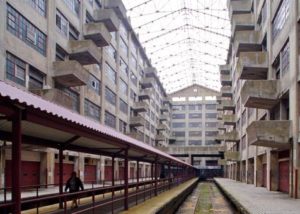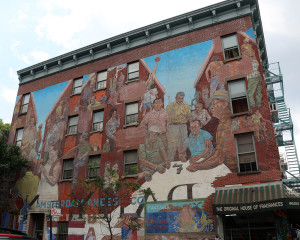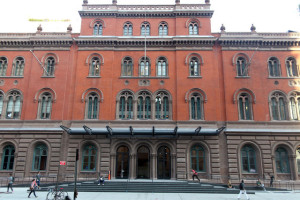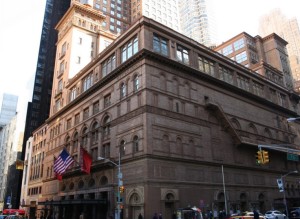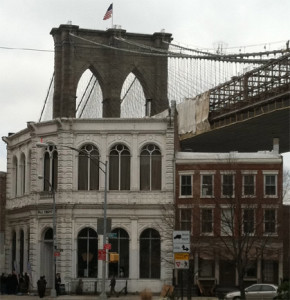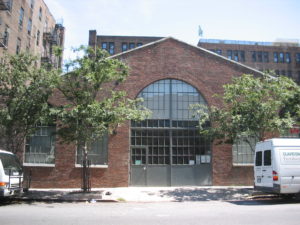Historic District Council
2015 Annual Preservation Conference Series
Landmarks at 50: Honoring Our Past, Imagining Our Future
March 2015
~Tour Locations will be sent to registered participants a week prior to the tour~
Brooklyn Army Terminal: A Public Institution Transformed
Saturday, March 7, 2015, 12PM
Once the largest military supply base in the United States, Sunset Park’s Brooklyn Army Terminal has transformed over the past 30 years from a campus of warehouses, offices, piers, and docks to a vibrant commercial hub, home to local artisans, manufacturers and cultural institutions. Designed by Cass Gilbert and completed in 1919, the Terminal’s Building B and its 52 acres of floor space was once the largest concrete structure in the world. Join guide Andrew Gustafson as we tour the massive complex, view the spectacular atrium of Building B and highlight the use, preservation and reuse of this former bustling hub of military industry as a new commercial center and part of the revitalized Brooklyn waterfront.
See photos from the tour here
East Harlem Histories
Saturday, March 14, 2015, 1PM
As East Harlem, also known as “El Barrio” or “Spanish Harlem,” transitions into becoming known as “SpaHa,” this tour will focus on some of the neighborhood’s diverse cultural and ethnic past. Join urban historian Justin Ferate to view delightful architectural treasures and cultural landmarks reflecting the neighborhood’s varied histories –from recent years and from generations past. Over its long history, East Harlem has been home to Cuban, Italian, Puerto Rican, African American, Jewish, Irish, Dutch, English, German, Haitian, Dominican, West African, Salvadoran, Greek and Mexican cultures – among others. Each group has left imprints on the community, but some of East Harlem’s touchstones are potentially endangered in the current reinvention of the neighborhood. Discover handsome civic structures such as the rustic brownstone Park Avenue Viaduct, the impressive Harlem Courthouse and religious edifices Learn of important cultural treasures, contemporary housing and vest-pocket parks created by Bette Midler’s New York Restoration Project. View enterprises such as the Julia de Burgos Latino Cultural Center. Learn of people associated with East Harlem such as Langston Hughes, Piri Thomas, Tito Puente, Celia Cruz, Vito Marcantonio, Paul Robeson, Fiorello LaGuardia, Manny Vega, Al Pacino, James de la Vega, and Melissa Mark-Viverito.
Friend- $10
General- $20
![]()
![]()
Village Institutions
Saturday, March 21, 2015, 11AM
Over the years, Greenwich Village has attracted an evolving roster of cultural and philanthropic organizations. Join architectural historian Matt Postal for a walking tour that considers the unique structures that these groups commissioned and ways in which these distinguished historic buildings have been thoughtfully adapted to contemporary purposes. Of particular interest will be the pioneering work of architect Giorgio Cavaglieri, who during the 1960s breathed new life into both the Astor Library (1853-81) and the Jefferson Market Courthouse (1874-77). Participants will learn about the history of these institutions and how specific structures have been preserved and re-imagined as schools, libraries, residences and performing art centers. Likely stops include Public School 16 (begun 1869), the Village Community Church (1847), the Mercantile Library (1890) and the original Whitney Museum of American Art (1838/1931).
Friend- $10
General- $20
Classical Culture at Carnegie Hall
Saturday, March 28, 2015 11AM
Skip the practice and get to Carnegie Hall with the Historic Districts Council! Arguably the most famous performance venue in the world, Carnegie Hall is an architectural gem inside and out. Designed by William Burnett Tuthill and completed in 1891, the building was funded by philanthropist Andrew Carnegie as part of his massive cultural endeavors. Join Carnegie Hall historians to tour the heart of this cultural icon, the iconic Isaac Stern Auditorium, home to world class music since the 19th century and named after the famous violinist whose efforts worked to save the building from demolition in the 1960s. We will also peek into the beautiful and newly created Resnick Educational Wing, home to the Weill Music Institute’s diverse educational programming.
Friend- $10
General- $20
SOLD OUT
DUMBO and Fulton Ferry
Saturday, April 11, 2015, 11AM
When the Fulton Ferry Historic District was designated in 1977, the small district, with its 15 buildings of mostly low-scale commercial and residential structures, recognized not only classic mid-19th century architecture, but also the pivotal part this area played in the early development of Brooklyn. Exactly 30 years later in 2007, Fulton Ferry’s neighbor DUMBO was designated, recognizing one of New York City’s most significant surviving industrial waterfront neighborhood. In contrast to Fulton Ferry, DUMBO consists of over 90 buildings, most of which were heroically-proportioned manufacturing structures and warehouses, epitomizing the late-19th- and early-20th-century industrial character of the Brooklyn waterfront. Join HDC board member and Director of the DUMBO Neighborhood Alliance Doreen Gallo for a walking tour of these diverse adjacent neighborhoods and a discussion of the current battles to maintain their historic integrity.
Friend- $10
General- $20
Preserving West Chelsea
Saturday April 18, 2015, 11AM
Between 1970 and 2009, three small but significant historic districts were designated by the Landmarks Preservation Commission in West Chelsea. Led by architectural historian Matt Postal, participants will walk through each district, tracing their shared history and evolution. While the Chelsea Historic District (and its extension) emphasized rows of fine-looking brick town houses and religious buildings that stood on property that was once owned by scholar and real estate developer Clement Clarke Moore, the later districts contain structures connected to the abolitionist movement and the Civil War, as well as the Hudson River’s evolution into a major mercantile center at the start of the 20th century. Highlights will include Cushman Row (1840), the General Theological Seminary (1838-1900), Empire Diner (1943), R.C. Williams Warehouse (1927-28), and a segment of the former New York Central Freight Railway (1929-34) now better known as the High Line.
Friend- $10
General- $20
SOLD OUT
Click here for information about the Keynote and Reception
and the Conference Panels
The title “Landmarks at 50: Honoring Our Past, Imagining Our Future” was created by Barbaralee Diamonstein-Spielvogel, Chair of the NYC Landmarks 50 Alliance, and is used with permission.
Support is provided in part by public funds from the New York City Department of Cultural Affairs in partnership with the City Council and by the New York State Council on the Arts with the support of Governor Andrew Cuomo and the New York State Legislature. Additional support is provided by City Councilmembers Margaret Chin, Inez Dickens, Matthieu Eugene, Daniel Garodnick, Vincent Gentile, Corey Johnson, Ben Kallos, Stephen Levin, Mark Levine, and Rosie Mendez.




